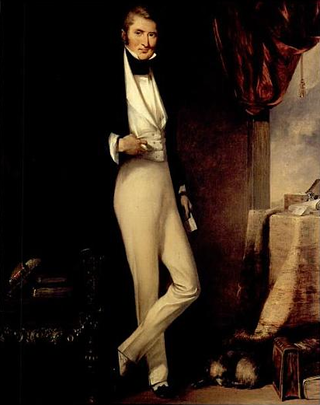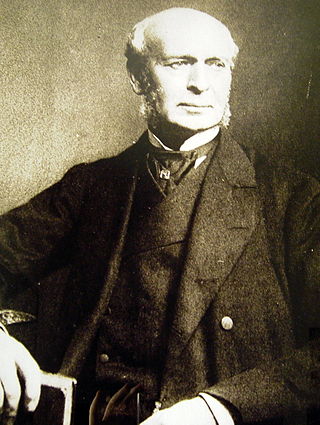Related Research Articles

William Jardine was a Scottish physician, opium merchant and trader who co-founded the Hong Kong based conglomerate Jardine, Matheson & Co. Following his return to England from the Far East, between 1841 and 1843, he was Member of Parliament for Ashburton representing the Whig party.

Dwarkanath Tagore was one of the first Indian industrialists to form an enterprise with British partners. He was the son of Ramlochon Tagore, the founder of the Jorasanko branch of the Tagore family. He was also the grandfather of Rabindranath Tagore.

Sir James Nicolas Sutherland Matheson, 1st Baronet, FRS, was a Scottish Tai-Pan. Born in Shiness, Lairg, Sutherland, Scotland, he was the son of Captain Donald Matheson. He attended Edinburgh's Royal High School and the University of Edinburgh. He and William Jardine went on to co-found the Hong Kong-based trading conglomerate Jardine Matheson & Co. that became today's Jardine Matheson Holdings.
The Keswick family are a business dynasty of Scottish origin associated with the Far East region since 1855 and in particular the conglomerate Jardine Matheson.

Dent & Co. or Dent's, was one of the wealthiest British merchant firms, or Hongs, active in China during the 19th century. A direct rival to Jardine, Matheson & Co, together with Russell & Co., these three companies are recognised as the original Canton Hongs active in early Colonial Hong Kong.

Hugh Mackay Matheson was a 19th-century Scottish industrialist, trader, Church of Scotland lay minister and supporter of Presbyterian church missions to China. He was the senior partner of Matheson and Company and founding company president of the Rio Tinto mining group.

Sylph was a clipper ship built at Sulkea, opposite Calcutta, in 1831 for the Parsi merchant Rustomjee Cowasjee. After her purchase by the Hong Kong-based merchant house Jardine Matheson, in 1833 Sylph set a speed record by sailing from Calcutta to Macao in 17 days, 17 hours. Her primary role was to transport opium between various ports in the Far East. She disappeared en route to Singapore in 1849.
Sir John Valentine Jardine Paterson was a Scottish businessman whose career was mostly in India.

Daniel Beale (1759–1842) was a Scottish merchant and fur trader active in the Far East mercantile centres of Bombay, Canton and Macau as well as at one time the Prussian consul in China.

Jardine, Matheson & Co., later Jardine, Matheson & Co., Ltd., forerunner of today's Jardine Matheson Holdings, was a Far Eastern company founded in 1832 by Scotsmen William Jardine and James Matheson as senior partners. Trafficking opium in Asia, while also trading cotton, tea, silk and a variety of other goods, from its early beginnings in Canton, in 1844 the firm established its head office in the new British colony of Hong Kong then proceeded to expand all along the China Coast.

Jardine Matheson Holdings Limited is a Hong Kong-based Bermuda-domiciled British multinational conglomerate. It has a primary listing on the London Stock Exchange and secondary listings on the Singapore Exchange and Bermuda Stock Exchange. The majority of its business interests are in Asia, and its subsidiaries include Jardine Pacific, Jardine Motors, Hongkong Land, Jardine Strategic Holdings, DFI Retail Group, Mandarin Oriental Hotel Group, Jardine Cycle & Carriage and Astra International. It set up the Jardine Scholarship in 1982 and Mindset, a mental health-focused charity, in 2002.

Red Rover was the name of two clipper ships.

Sir Apcar Alexander Apcar was a wealthy Armenian businessman in Calcutta, India. His family had made their fortune in the opium trade with China. He was president of the Bengal Chamber of Commerce, sat on the Imperial Legislative Council, and in 1903 was knighted. He owned a racehorse stud, and for several years was the leading figure in the Indian racing world.
Apcar and Company was a firm founded in 1819 in India that engaged in shipping, import and export. The most profitable trade was in opium, shipped from India to Hong Kong and the Pearl River. The Apcar Line also carried Indian and Chinese laborers for work in Malaya and Singapore. The line was sold to the British India Steam Navigation Company in 1912.
Matheson & Company was a London-based trading house closely associated with Jardine Matheson of Hong Kong and Jardine Skinner of Calcutta. It arranged finance and handled imports from those two companies of products such as tea, silk and jute. Matheson & Company also became involved in venture-capital, specializing in mining. The company was a member of the consortium that formed the Rio Tinto Company. After 1912 it became a subsidiary of Jardine Matheson.

David Sassoon & Co., Ltd. was a trading company operating in the 19th century and early 20th century predominantly in India, China and Japan.

The destruction of opium at Humen began on 3 June 1839 and involved the destruction of 1,000 long tons of illegal opium seized from British traders under the aegis of Lin Zexu, an Imperial Commissioner of Qing China. Conducted on the banks of the Pearl River outside Humen Town, Dongguan, China, the action provided casus belli for Great Britain to declare war on Qing China. What followed is now known as the First Opium War (1839–1842), a conflict that initiated China's opening for trade with foreign nations under a series of treaties with the western powers.
Hercules was built at Calcutta in 1814. She acquired British registry and traded between Britain and India under a license from the British East India Company (EIC), before returning to Calcutta registry. She then traded opium between India and China, and became an opium receiving ship for Jardine Matheson. In 1839 she was one of the vessels that surrendered her store of opium to be burned at the behest of Chinese officials at Canton. This incident was one of the proximate causes of the First Opium War (1839–1842). Her owners apparently sold her to American owners in 1839.
The Acland Mill was the first jute mill established in India. The mill was established in 1855 by British entrepreneur George Acland and Bengali financier Babu Bysumber Sen in Rishra, Bengal Presidency, British India.
References
Citations
- 1 2 3 4 Chapman 2004, p. 114.
- ↑ Misra 1999, p. 29.
- ↑ Misra 1999, p. 32.
- ↑ Pichon 2006, p. 529.
- ↑ Jones 2002, p. 52.
- 1 2 Jones 2000, p. 33.
- ↑ Harcourt 2006, p. 104.
- ↑ Munro 2003, p. 58.
- ↑ Harcourt 2006, p. 92.
- ↑ Harcourt 2006, p. 93.
- ↑ Harcourt 2006, p. 106.
- ↑ Trocki 1999, p. 112.
- ↑ Chapman 2004, p. 99.
- ↑ Munro 2003, p. 29.
- ↑ Harvey 1981, p. 8.
- ↑ Munro 2003, p. 16.
- 1 2 Chapman 2004, p. 115.
- ↑ Harvey 1981, p. 9.
- ↑ Misra 1999, p. 24.
- ↑ Wilkins & Schröter 1998, p. 208.
- ↑ Misra 1999, p. 40.
- ↑ Chapman 2004, p. 124.
- ↑ Bagchi 1970, p. 236.
- ↑ Stewart 1998, p. 89.
- ↑ Wilkins & Schröter 1998, p. 207.
- ↑ Welcome to Jardine Henderson Limited.
- ↑ About Jardine Henderson Limited.
- ↑ "Jardine Henderson – Corporate Website" . Retrieved 2021-04-10.
Sources
- "About Jardine Henderson Limited", Indiamart, Jardine Henderson, retrieved 2016-03-13
- Bagchi, Amiya Kumar (1970). "European and Indian Entrepreneurship in India, 1900-30". Elites in south asia. CUP Archive. GGKEY:R8YQ4FKC94Z. Retrieved 2013-11-10.
- Chapman, Stanley (2004-01-29). Merchant Enterprise in Britain: From the Industrial Revolution to World War I. Cambridge University Press. ISBN 978-0-521-89362-6 . Retrieved 2013-11-07.
- Harcourt, Freda (2006-09-05). Flagships of Imperialism: The P & O Company and the Politics of Empire from Its Origins to 1867. Manchester University Press. ISBN 978-1-84779-145-0 . Retrieved 2013-11-05.
- Harvey, Charles E. (1981). The Rio Tinto Company: An Economic History of a Leading International Mining Concern, 1873-1954 . Alison Hodge Publishers. p. 8. ISBN 978-0-906720-03-5 . Retrieved 2013-11-07.
- Jones, Geoffrey (2000). Merchants to Multinationals: British Trading Companies in the Nineteenth and Twentieth Centuries. Oxford University Press. ISBN 978-0-19-829450-4 . Retrieved 2013-11-07.
- Jones, Geoffrey G (2002-06-01). The Multinational Traders. Routledge. ISBN 978-0-203-45070-3 . Retrieved 2013-11-10.
- Misra, Maria (1999-04-29). Business, Race, and Politics in British India, c.1850-1960. Oxford University Press. ISBN 978-0-19-154268-8 . Retrieved 2013-11-10.
- Munro, J. Forbes (2003). Maritime Enterprise and Empire: Sir William Mackinnon and His Business Network, 1823-93. Boydell Press. ISBN 978-0-85115-935-5 . Retrieved 2013-11-05.
- Pichon, Alain Le (2006-08-10). China Trade and Empire: Jardine, Matheson & Co. and the Origins of British Rule in Hong Kong, 1827-1843. Oxford University Press. ISBN 978-0-19-726337-2 . Retrieved 2013-11-10.
- Stewart, Gordon Thomas (1998). Jute and Empire: The Calcutta Jute Wallahs and the Landscapes of Empire. Manchester University Press. ISBN 978-0-7190-5439-6 . Retrieved 2013-11-07.
- Trocki, Carl A. (1999). Opium, Empire and the Global Political Economy: A Study of the Asian Opium Trade, 1750-1950. Routledge. ISBN 978-0-415-21500-8 . Retrieved 2013-11-10.
- Welcome to Jardine Henderson Limited, Jardine Henderson, retrieved 2016-03-13
- Wilkins, Mira; Schröter, Harm G. (1998). The Free-standing Company in the World Economy, 1830-1996. Oxford University Press. ISBN 978-0-19-829032-2 . Retrieved 2013-11-10.